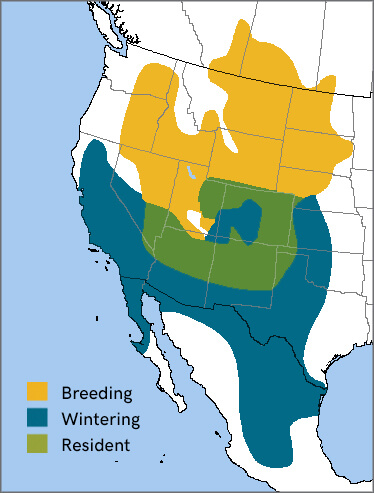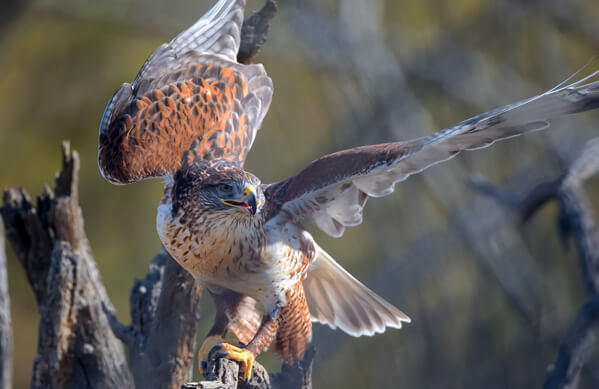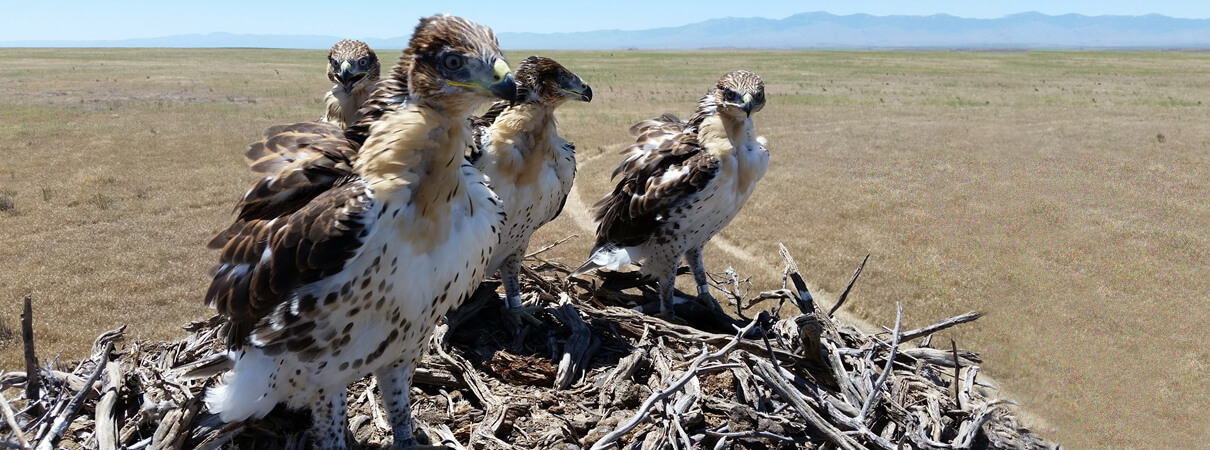
Ferruginous Hawk range map, NatureServe
The regal Ferruginous Hawk ranks as the biggest North American member of the genus Buteo, a group of stocky hawks with long, broad wings. It is even noticeably larger than the robust and familiar Red-tailed Hawk. This species is named for the ferruginous, or rusty, color on the wings, back, and legs of light-morph individuals.
Almost an Eagle
The Ferruginous Hawk could easily be mistaken for an eagle. Noted ornithologist Arthur Cleveland Bent evocatively described the Ferruginous Hawk as “the largest, most powerful, and grandest of our buteos, a truly regal bird."
Among this hawk's eagle-like qualities are its large size — about two feet long with an impressive 4.7-foot wingspan. In flight, it rows through the air with slow, strong wing beats or soars with wings held flat or in a V-shaped dihedral similar to a Turkey Vulture's flight profile.
The Ferruginous Hawk also looks more eagle-like than other buteos thanks to its large bill and long, yellow gape, which reaches back as far as the eye. The large gape may increase the bird's efficiency at panting, which enhances temperature regulation and is an important asset for wildlife of hot, wide-open spaces.
Its fully feathered legs are another feature it shares with the Golden Eagle. Even this big hawk's call is eagle-like, weak and somewhat wavering. See what you think by comparing these two recordings:
(Audio of Ferruginous Hawk by Andrew Spencer, XC77780. Accessible at www.xeno-canto.org/77780. Audio of Red-tailed Hawk by Lauri Hallikainen, XC233241. Accessible at www.xeno-canto.org/233241)
Haunting Open Country
The Ferruginous Hawk occurs only in North America, from southwestern Canada through the western United States and into northern Mexico. It haunts arid, open country, including short-grass prairie, sagebrush, deserts with short vegetation, and nearby agricultural areas. One thing these habitats have in common, aside from varied prey, is the existence of prominent perches. Lone trees, fence posts, powerline poles, and rocky outcrops are all used as places to perch and wait for prey.
This big hawk is found in two distinct color morphs: Light-morph individuals have pale gray heads, rufous barring on the breast, and rusty legs and wings. Dark-morph birds, which are far less common, are generally dark brown all over.
Hunting Like a Velociraptor
Rabbits, ground squirrels, prairie dogs, and other small- to medium-sized mammals comprise the bulk of a Ferruginous Hawk's diet. But this species can be flexible in its food choices and will also catch and eat birds ranging in size from the Greater Sage-Grouse to the Horned Lark, as well as reptiles, amphibians, and even large insects.
The Ferruginous Hawk uses a remarkable variety of hunting techniques. It perches and uses a "sit and wait" strategy like many other buteos. It flies low over the ground like a Northern Harrier, dropping onto prey from above. Lurking near rodent holes, the Ferruginous Hawk grabs emerging animals by surprise. And it pursues prey on foot like a modern-day velociraptor, sometimes even hunting cooperatively in the manner of the Harris's Hawk.
Nesting in Wide-Open Spaces
The female Ferruginous Hawk is larger than the male, as is the case with the Great Horned Owl, Peregrine Falcon, and most other birds of prey. Pairs are monogamous and may remain together throughout their adult lives. Their courtship displays involve both birds circling high in the air, with the male diving and rising above the female. The birds then grasp each other's beaks and talons while spiraling toward the ground, calling all the while.
Like the Bald Eagle, the Ferruginous Hawk builds a large stick nest, usually in an isolated, open location. Nests may be built on solitary trees, cliff ledges, haystacks, or even on man-made structures such as windmills and powerline poles. This species will even nest on elevated spots on the ground, although these clutches are usually less successful due to predation by coyotes, bobcats, and foxes.
Both members of the pair build or refurbish the stick nest, which may be re-used year after year, adding a lining of grass, bark, and even cow chips! Similar to the Osprey, the Ferruginous Hawk shows unusual taste in nest material choices, sometimes incorporating items such as metal cable, barbed wire, and plastic. Before bison were extirpated across much of the West, Ferruginous Hawks often placed their bones and wool in nests.
Learning to Fly
The Ferruginous Hawk raises only one brood per season, with the female laying three to five eggs when conditions are right. The number of young a pair can successfully raise depends upon the cyclical abundance of its mammalian prey, a breeding strategy also seen in the Snowy Owl. In years of abundance, a Ferruginous Hawk pair may successfully raise up to five young, but in other years may raise no young at all. The parents take turns brooding the clutch; even after the chicks hatch, the parents continue to sit on them for several days to ensure the young birds don't overheat or get too cold.
Ferruginous Hawks grow quickly and are fully feathered and ready to fly at five to six weeks old. Once fledged, the young spend the next few weeks in their parents' territory as they learn to hunt and survive on their own.
A Fate Linked to Grasslands
Ferruginous Hawks are sensitive to human disturbance and will often abandon a territory or nest site when encroached upon. Among the threats they face are loss of native grasslands, which affects many other birds from the Long-billed Curlew to the Mountain Plover. Increasing numbers of wind turbines are another significant problem: Ferruginous Hawks, Golden Eagles, and other raptors have been killed by spinning rotor blades at western wind energy facilities. Careful study and siting are critically important to reduce the frequency of such collisions. For birds, the sky is a habitat too — one that is increasingly threatened.
Several ABC conservation efforts benefit the Ferruginous Hawk and other birds that share its habitat. ABC has long supported Mexican partner Pronatura Noreste in conserving El Tokio, one of the largest intact desert grasslands remaining south of the U.S. border. These grasslands are the last refuge for the Endangered Worthen's Sparrow and Mexican Prairie Dog, as well as migrants including the Ferruginous Hawk and Sprague's Pipit.
ABC's Bird-Smart Wind Energy program advocates for the mindful placement of turbines in order to minimize impacts on birds, while our Policy and Advocacy team takes action to conserve the sagebrush habitat vital to the Ferruginous Hawk, Greater Sage-Grouse, and many other birds. We also take action to control deadly anticoagulant rodenticides that poison raptors and other unintended victims.
Donate to support ABC's conservation mission!




















































